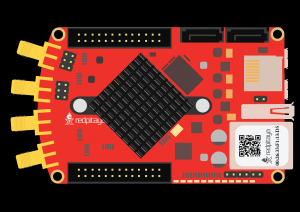2.3.6.3.3. Generate a signal on external trigger
2.3.6.3.3.1. Description
This example shows how to program Red Pitaya to generate an analog signal on an external trigger. Red Pitaya will first wait for a trigger from an external source and start generating the desired signal right after the trigger condition is met. The same concept also works for continuous signal generation on external trigger Voltage and frequency ranges depending on the Red Pitaya model.
2.3.6.3.3.3. SCPI Code Examples
2.3.6.3.3.3.1. Code - MATLAB®
The code is written in MATLAB. In the code, we use SCPI commands and TCP client communication. Copy the code from below into the MATLAB editor, save the project, and hit the “Run” button.
%% Define Red Pitaya as a TCP client object
clc
clear all
close all
IP = '192.168.178.56'; % Input IP of your Red Pitaya...
port = 5000;
RP = tcpclient(IP, port);
%% Open connection with your Red Pitaya
RP.ByteOrder = "big-endian";
configureTerminator(RP,"CR/LF");
flush(RP); % clear input & output buffers
% flush(RP, 'input')
% flush(RP, 'output')
% Reset Generation
writeline(RP, 'GEN:RST')
%% GENERATION
writeline(RP,'SOUR1:FUNC SINE'); % Set function of output signal {sine, square, triangle, sawu, sawd, pwm}
writeline(RP,'SOUR1:FREQ:FIX 200'); % Set frequency of output signal
writeline(RP,'SOUR1:VOLT 1'); % Set amplitude of output signal
writeline(RP,'SOUR1:BURS:STAT BURST'); % Set burst mode to CONTINUOUS for sine wave generation on External trigger
writeline(RP,'SOUR1:BURS:NCYC 1'); % Set 1 pulses of sine wave
% For short triggering signals set the length of internal debounce filter in us (minimum of 1 us)
writeline(RP,'SOUR:TRig:EXT:DEBouncerUs 500'); % OS 2.00 and above
writeline(RP,'SOUR1:TRig:SOUR EXT_PE'); % Set generator trigger to external
writeline(RP,'OUTPUT1:STATE ON'); % Set output to ON
% For generating signal pulses, your trigger signal frequency must be less than
% frequency of generating signal pulses. If your trigger signal frequency
% is higher than the frequency of generating signal pulses
% you will get a continuous signal on output, instead of pulses.
clear RP;
2.3.6.3.3.3.2. Code - Python
Using just SCPI commands:
#!/usr/bin/env python3
import sys
import redpitaya_scpi as scpi
IP = '192.168.178.56'
rp_s = scpi.scpi(IP)
wave_form = 'sine'
freq = 200
ampl = 1
rp_s.tx_txt('GEN:RST')
rp_s.tx_txt('SOUR1:FUNC ' + str(wave_form).upper())
rp_s.tx_txt('SOUR1:FREQ:FIX ' + str(freq))
rp_s.tx_txt('SOUR1:VOLT ' + str(ampl))
rp_s.tx_txt('SOUR1:BURS:STAT BURST') # Set burst mode to CONTINUOUS/skip this section for sine wave generation on External trigger
rp_s.tx_txt('SOUR1:BURS:NCYC 1')
# For short triggering signals set the length of internal debounce filter in us (minimum of 1 us)
rp_s.tx_txt('SOUR:TRig:EXT:DEBouncerUs 500')
rp_s.tx_txt('SOUR1:TRig:SOUR EXT_PE')
rp_s.tx_txt('OUTPUT1:STATE ON')
rp_s.close()
Using functions:
#!/usr/bin/env python3
import sys
import redpitaya_scpi as scpi
IP = '192.168.178.56'
rp_s = scpi.scpi(IP)
wave_form = 'sine'
freq = 200
ampl = 1
rp_s.tx_txt('GEN:RST')
# Function for configuring a Source
rp_s.sour_set(1, wave_form, ampl, freq, burst=True, ncyc=1, trig="EXT_PE")
# For short triggering signals set the length of internal debounce filter in us (minimum of 1 us)
rp_s.tx_txt('SOUR:TRig:EXT:DEBouncerUs 500')
rp_s.tx_txt('OUTPUT1:STATE ON')
rp_s.close()
Note
The Python functions are accessible with the latest version of the redpitaya_scpi.py document available on our GitHub. The functions represent a quality-of-life improvement as they combine the SCPI commands in an optimal order and also check for improper user inputs. The code should function at approximately the same speed without them.
For further information on functions please consult the redpitaya_scpi.py code.
2.3.6.3.3.4. API Code Examples
Note
The API code examples don’t require the use of the SCPI server. Instead, the code should be compiled and executed on the Red Pitaya itself (inside Linux OS). Instructions on how to compile the code and other useful information are here.
2.3.6.3.3.4.1. Code - C API
/* Red Pitaya C API example of Generation a signal on a external trigger */
#include <stdio.h>
#include <stdlib.h>
#include <unistd.h>
#include "rp.h"
int main(int argc, char **argv){
/* Print error, if rp_Init() function failed */
if(rp_Init() != RP_OK){
fprintf(stderr, "Rp api init failed!\n");
}
/* Reset Generation */
rp_GenReset();
/* Generation */
rp_GenWaveform(RP_CH_1, RP_WAVEFORM_SINE);
rp_GenFreq(RP_CH_1, 200);
rp_GenAmp(RP_CH_1, 1);
rp_GenBurstCount(RP_CH_1, 1);
rp_GenMode(RP_CH_1, RP_GEN_MODE_BURST);
rp_GenSetExtTriggerDebouncerUs(500);
rp_GenTriggerSource(RP_CH_1, RP_GEN_TRIG_SRC_EXT_PE);
rp_GenOutEnable(RP_CH_1);
/* Release rp resources */
rp_Release();
return 0;
}
2.3.6.3.3.4.2. Code - Python API
#!/usr/bin/python3
import time
import rp
#? Possible waveforms:
#? RP_WAVEFORM_SINE, RP_WAVEFORM_SQUARE, RP_WAVEFORM_TRIANGLE, RP_WAVEFORM_RAMP_UP,
#? RP_WAVEFORM_RAMP_DOWN, RP_WAVEFORM_DC, RP_WAVEFORM_PWM, RP_WAVEFORM_ARBITRARY,
#? RP_WAVEFORM_DC_NEG, RP_WAVEFORM_SWEEP
channel = rp.RP_CH_1 # rp.RP_CH_2
waveform = rp.RP_WAVEFORM_SINE
freq = 200
ampl = 1
ncyc = 2 # Number of waveform periods in one burst
nor = 2 # Number of repeated bursts
period = 30000 # Delay between start of first burst and start of second burst
# in mircoseconds
debounce_len = 50000 # microseconds
#? Possible modes:
#? RP_GEN_MODE_CONTINUOUS, RP_GEN_MODE_BURST
mode = rp.RP_GEN_MODE_BURST
#? Possible trigger sources:
#? RP_GEN_TRIG_SRC_INTERNAL, RP_GEN_TRIG_SRC_EXT_PE, RP_GEN_TRIG_SRC_EXT_NE
gen_trig_sour = rp.RP_GEN_TRIG_SRC_EXT_PE
# Initialize the interface
rp.rp_Init()
# Reset generator
rp.rp_GenReset()
###### Generation #####
rp.rp_GenWaveform(channel, waveform)
rp.rp_GenFreqDirect(channel, freq)
rp.rp_GenAmp(channel, ampl)
# Change to burst mode
rp.rp_GenMode(channel, mode)
rp.rp_GenBurstCount(channel, ncyc) # Ncyc
rp.rp_GenBurstRepetitions(channel, nor) # Nor
rp.rp_GenBurstPeriod(channel, period) # Period
# Set length of internal debounce filter in us (minimum of 1 us)
rp.rp_GenSetExtTriggerDebouncerUs(debounce_len)
# Specify generator trigger source
rp.rp_GenTriggerSource(channel, gen_trig_sour)
# Enable output
rp.rp_GenOutEnable(channel)
# Release resources
rp.rp_Release()

